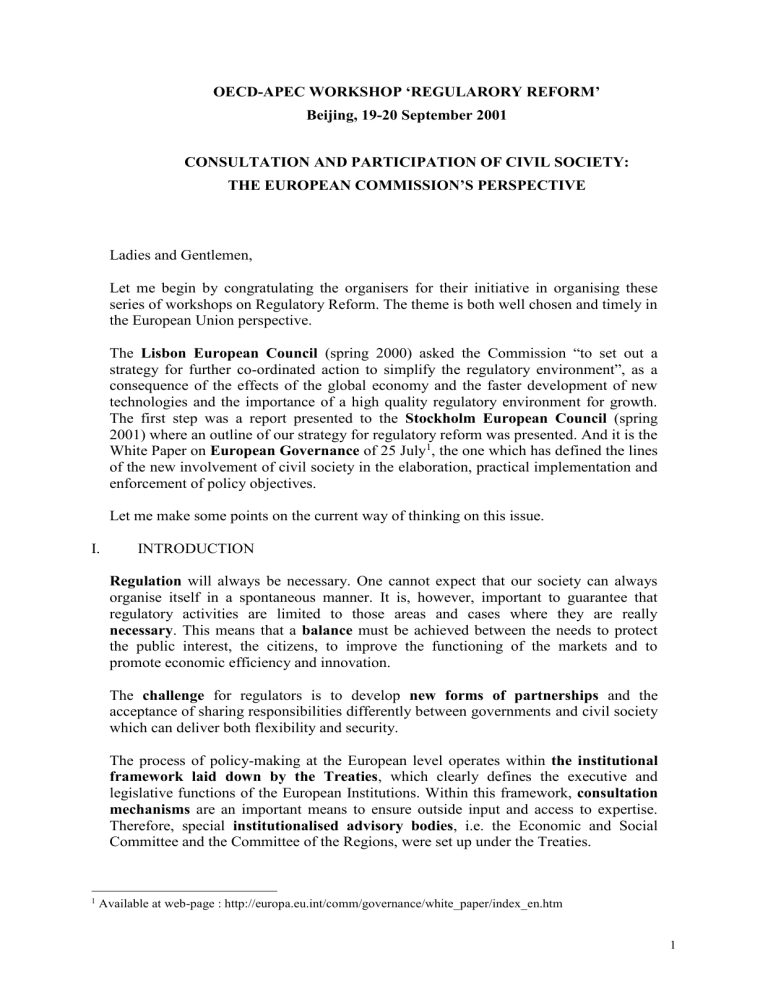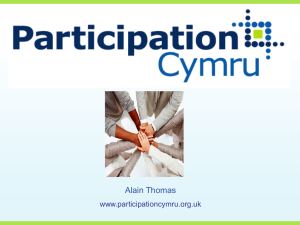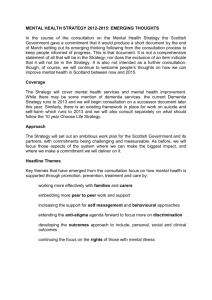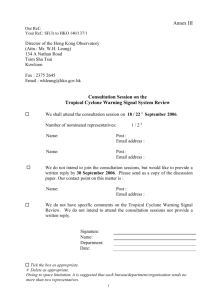CONSULTATION AND PARTICIPATION OF CIVIL SOCIETY

OECD-APEC WORKSHOP ‘REGULARORY REFORM’
Beijing, 19-20 September 2001
CONSULTATION AND PARTICIPATION OF CIVIL SOCIETY:
THE EUROPEAN COMMISSION’S PERSPECTIVE
Ladies and Gentlemen,
Let me begin by congratulating the organisers for their initiative in organising these series of workshops on Regulatory Reform. The theme is both well chosen and timely in the European Union perspective.
The Lisbon European Council (spring 2000) asked the Commission “to set out a strategy for further co-ordinated action to simplify the regulatory environment”, as a consequence of the effects of the global economy and the faster development of new technologies and the importance of a high quality regulatory environment for growth.
The first step was a report presented to the Stockholm European Council (spring
2001) where an outline of our strategy for regulatory reform was presented. And it is the
White Paper on European Governance of 25 July 1 , the one which has defined the lines of the new involvement of civil society in the elaboration, practical implementation and enforcement of policy objectives.
Let me make some points on the current way of thinking on this issue.
I.
INTRODUCTION
Regulation will always be necessary. One cannot expect that our society can always organise itself in a spontaneous manner. It is, however, important to guarantee that regulatory activities are limited to those areas and cases where they are really necessary . This means that a balance must be achieved between the needs to protect the public interest, the citizens, to improve the functioning of the markets and to promote economic efficiency and innovation.
The challenge for regulators is to develop new forms of partnerships and the acceptance of sharing responsibilities differently between governments and civil society which can deliver both flexibility and security.
The process of policy-making at the European level operates within the institutional framework laid down by the Treaties , which clearly defines the executive and legislative functions of the European Institutions. Within this framework, consultation mechanisms are an important means to ensure outside input and access to expertise.
Therefore, special institutionalised advisory bodies , i.e. the Economic and Social
Committee and the Committee of the Regions, were set up under the Treaties.
1 Available at web-page : http://europa.eu.int/comm/governance/white_paper/index_en.htm
1
Wide consultation of civil society organisations by the European Commission is therefore not a new phenomenon . In fact, the Commission has a long tradition of consulting outside interest groups in the formulation of its policies. The European
Union's legal framework states that "the Commission should (...) consult widely before proposing legislation and, wherever appropriate, publish consultation documents" .
2
In addition, all European bodies have a strong tradition of direct contacts with outside civil society organisations. These contacts are aimed at contributing to a policy-making process that reflects the diversity of interests, perspectives and needs in the European
Union. But consultation processes run by the Commission can never be a substitute for political mediation (legislator).
However, consultation, if carried out properly, can provide valuable expertise laying the ground for - technically and economically- sound decisions. In particular, consultation helps reconcile the views and concerns of different actors throughout the policy-cycle
(i.e. in policy-shaping, implementation and evaluation), thereby obtaining wide support and social acceptance for decisions. Consultation is therefore an important means to improve effectiveness and efficiency of the Commission’s activities. Citizens are no longer passive objects of the administrative process but have an active role to play.
Moreover, information technology has given opportunities for greater scrutiny of public administration performance by providing citizens with new instruments of communication and information. Public administration both at national and at European level is now more open and transparent than a few years ago. However, greater openness has also changed citizens' expectations and they are now more demanding of information, explanations and justifications than hitherto.
II.
WHAT ARE PUBLIC AUTHORITIES EXPECTED TO DO?
The success of regulatory systems can be measured as their ability to accomplish their policy objectives. The first step in establishing whether regulation is necessary is to be clear about the objectives of the action envisaged and to identify the public interest at stake. Information needs to be put together in a systematic way to allow a thorough analysis of the causes of the identified problem (including the impact of existing regulations and other initiatives), the availability and possible contributions of different policy instruments and the existing and likely future behaviour of the stakeholders.
This analysis will in turn allow the definition of feasible policy objectives and subsequently the determination by public authorities of the most appropriate solution.
But the key question remains to know whether the issue at stake necessitates legislation.
1.
What is the problem to be solved?
In order to detect the problem at stake, public authorities need to collect data through specific mechanisms . Only after an analysis of the causes of the identified problems, can feasible policy objectives be defined and then the most appropriate solution determined. That is to say that only when the problem is clearly understood, can it be decided whether objectives can be more effectively attained through regulation or other means. The regulator is then in a position to use the least coercive and most effective means to achieve that objective.
2 Protocol (N° 30) on the application of the principles of subsidiarity and proportionality, adopted via the Amsterdam Treaty.
2
The identification of the objectives is a necessary step, but it is not sufficient in itself to decide whether a regulatory measure is needed. Regulatory policy makers need a clear understanding of the nature of different policy instruments, of the habits of the regulated stakeholders, and of the regulatory context . Questions need to be posed taking into account the current industry structure and future developments in the sector. In other words, the context in which the problem appears or can be expected to appear. To know how the individual organisations are structured and make decisions is crucial.
2. How can regulators know the impact of their decisions?
Public authorities will have to make the final decision on the choice between regulatory systems, including no regulation. However, it is important that their decisions are enlightened by consultation with stakeholders, involving the latter in the definition of policy objectives. A first consequence will be to broaden the dialogue with stakeholders, developing more open and transparent consultation mechanisms with the civil society. A participatory approach has the potential to achieve decisions that are supported by most of those who are likely to be affected. Not just because they agree with the desired outcomes but, more importantly, because they have been able to contribute to their shaping.
Moreover, we need to further seek the answers to the impact of legislation; to find the right balance of costs and benefits to society. In every single legislative proposal, at national or Community level, the right balance between costs and benefits for business, consumers, citizens in general and the environment must be found. Regulators need to further seek the answer to a qualitative and quantitative impact assessment of legislation, and in so far as possible evidence-based analysis, to find the right balance between burdens and advantages to society.
3. Who must be consulted?
The drafting of a proposal will involve close collaboration and consultation with a wide variety of groups. It implies to consult, where appropriate and according to the rules on access to public documents , widely and transparently, giving access in so far as practicable to the results of the consultation as well as to the consultation documents.
Identify the categories of stakeholders that need to be consulted is important. Those who are likely to be affected may be more likely to comply with rules in the development of which they have participated. The development of a broad consultation system means an increasing degree of co-operation, in vertical terms between different government levels, and in horizontal terms among several groups of actors. The more the rules are in line with their own goals, the more the degree of stakeholders’ ownership .
It is clear that such consultations have to be managed efficiently in order to avoid slowing down the regulatory process unnecessarily . But time spent in an effective upstream consultation will often be recovered later in the process.
Different forms of consultation may be appropriate for different policy areas and for different stages in the process. Green papers, advisory committees, business test panels or other forms of consultation addressed to civil society and the public at large may be suitable for the preliminary stage of the policy-making process, while the drafting stage
3
of a legislative proposal is likely to require close collaboration with a more narrowly targeted group of stakeholders.
The Business Test Panel project 3 aims at improving the Commission’s regulatory impact analysis procedures and in this way adopt better quality proposals. It focuses on the compliance costs and administrative burdens that may hinder the development of trade and industry. As a supplement to the normal consultation procedures. The BTP must be representative (comprising firms of all sizes and broad geographical and industrial coverage), provide reliable results, impose light administrative burdens, be operational and confidentiality must be assured. Each Member States is responsible to set up a panel structure.
Policy-makers should, in addition to conducting specific consultations, also make use of mechanisms that produce permanent feedback. In its Inter-Active Policy Making
Initiative 4 , making use of e-tools, the European Commission is setting up a multipolicy data base to collect and analyse the spontaneous reactions of businesses and citizens in the marketplace. It involves a feedback mechanism which helps to collect spontaneous reactions in the market place; and, a consultation mechanism allowing a more rapid and structured collection of stakeholders’ reactions to new initiatives. These mechanisms are enhancing the Commission’s ability to assess the impact of EU policies
(or the absence of them) on the ground, to evaluate proposals for new actions, to respond rapidly and in a targeted manner to problems or issues that emerge, and to be more accountable for its actions.
Seeking answers through open and transparent procedures is key, but it requires an active and constructive approach from stakeholders . Interest groups need to organise themselves at European level to the extent to which that is the more efficient way to achieve their goals and be able to demonstrate that they are representative, to present consensual viewpoints, backed by rational arguments based on reliable technical expertise, to develop a European perspective and to play an active role in the implementation process.
III.
CONCLUSIONS
A reinforced culture of consultation and dialogue is needed. In this sense, the White
Paper on European Governance of 25 July 2001 proposes a code of conduct for the institution that sets minimum standards, focusing on what to consult on, when, whom and how to consult. Moreover, greater transparency will be achieved through the establishment of a comprehensive database providing information on civil society organisations active at European level. The civil society organisations will be invited to provide information on their objectives, their membership structure, sources of finance and their methods for consulting their members.
[This will be accompanied by introducing a more coherent system through guidelines setting minimum standards for consultation procedures throughout the European
Commission. These will include what to consult on, how to apply the principle of early consultation, the criteria for identifying the relevant stakeholders, practical guidance on how to carry out the actual procedure, how to present the results of the consultation to the political decision-makers and last but not least how to provide feedback to the
3 http://europa.eu.int/comm/internal_market/en/update/panel/index.htm
4 www.europa.eu.int/comm/internal_market/en/update/citizen/ipm.htm
4
stakeholders who were consulted. The guidelines will need to be monitored and evaluated to ensure maximum effectiveness.]
Civil society increasingly sees Europe as offering a good platform to change policy orientations and society. It is a chance to get citizens more actively involved in achieving the Union’s objectives and to offer them a structured channel for feedback , criticism and protest. Civil society is going to be constantly invited to deliver credible, effective and verifiable solutions. Economic changes require both governments and civil society to reassess their traditional roles and remits. Dialogue is a key element.
Thank you for your attention.
Economic and Social Committee in its Opinion of 22 September 1999
5
:
“Civil society organisations include:
the so-called labour-market players, [i.e. trades unions and employers federations – also called the “social partners”]
;
organisations representing social and economic players, which are not social partners in the strict sense of the term;
NGOs (non-governmental organisations) which bring people together in a common cause, such as environmental organisations, human rights organisations, consumer associations, charitable organisations, educational and training organisations, etc.;
CBOs (community-based organisations, i.e. organisations set up within society at grassroots level which pursue member-oriented objectives), e.g. youth organisations, family associations and all organisations through which citizens participate in local and municipal life;
religious communities.”
5 Official Journal of the European Communities (1999 / C329/10)
5







